Introduction:
Growing cannabis outdoors can be an incredibly rewarding experience, offering the chance to cultivate potent and flavorful buds in a natural environment. Whether you’re a seasoned gardener or a novice enthusiast, cultivating cannabis outdoors allows you to harness the power of the sun and the earth to produce high-quality yields.
In this comprehensive guide, we’ll walk you through the essential steps to successfully grow cannabis outdoors, from selecting the right strain to harvesting your crop.

- Selecting the Right Strain: Choosing the right strain is crucial for outdoor cultivation success. Factors to consider include climate, sunlight exposure, and desired effects. Some strains thrive in warm, sunny climates, while others are more resilient to cooler temperatures. Additionally, consider the plant’s size and growth characteristics; some strains may be better suited for discreet growing or limited space.
- Preparing the Growing Site: Selecting an appropriate growing site is essential for maximizing your plant’s potential. Look for a location with ample sunlight, preferably at least six hours of direct sunlight per day. Ensure the site has good drainage to prevent waterlogging, as cannabis plants are susceptible to root rot. Consider security and privacy concerns, especially if growing in a location where cannabis cultivation is regulated.
- Soil Preparation: Prepare the soil before planting by tilling the ground and removing any debris or weeds. Test the soil pH to ensure it falls within the optimal range for cannabis cultivation, typically between 6.0 and 7.0. Amend the soil with organic matter such as compost or aged manure to improve nutrient availability and soil structure. This step is crucial for providing a fertile growing medium for your cannabis plants.
- Germination and Planting: Start your cannabis plants from seeds or clones, ensuring they are sourced from reputable sources. Germinate the seeds by placing them in a damp paper towel until they sprout, then transplant them into small pots filled with nutrient-rich soil. Once the seedlings have developed a few sets of true leaves, transplant them into their final outdoor growing location, spacing them according to their mature size.
- Watering and Nutrient Management: Water your cannabis plants regularly, ensuring the soil remains consistently moist but not waterlogged. Avoid overwatering, as this can lead to root rot and other issues. Monitor nutrient levels in the soil and supplement as needed with organic fertilizers or compost teas. Be mindful of nutrient deficiencies and excesses, adjusting your feeding regimen accordingly.
- Pest and Disease Management: Keep a close eye on your cannabis plants for signs of pests or diseases, as outdoor cultivation makes them more susceptible to infestations. Implement preventative measures such as companion planting, beneficial insects, and natural pesticides to protect your plants. Regularly inspect the foliage and underside of leaves for pests such as aphids, spider mites, and caterpillars, addressing any issues promptly.
- Training and Pruning: Train your cannabis plants to optimize light exposure and airflow, which can help increase yields and reduce the risk of mold and mildew. Techniques such as topping, pruning, and low-stress training (LST) can encourage lateral growth and bud development. Additionally, consider using trellises or stakes to support heavy branches and prevent breakage.
- Flowering and Harvesting: As the days shorten and the nights lengthen, your cannabis plants will enter the flowering stage. Monitor the trichomes on the buds to determine the optimal time for harvesting. Trichomes should appear milky white or amber in color, indicating peak potency. Use sharp scissors to carefully trim the buds from the plant, removing excess foliage and stems. Hang the buds upside down in a dark, well-ventilated area to dry slowly over 1-2 weeks, then cure them in airtight containers for an additional 2-4 weeks to enhance flavor and potency.
Conclusion:
Growing cannabis outdoors can be a fulfilling and enjoyable endeavor, providing an opportunity to connect with nature and produce your own high-quality buds. By following the steps outlined in this guide, you can cultivate healthy, robust plants and enjoy a bountiful harvest of potent and flavorful cannabis. Remember to research local regulations and cultivate responsibly, respecting both the plant and the environment. Happy growing!
